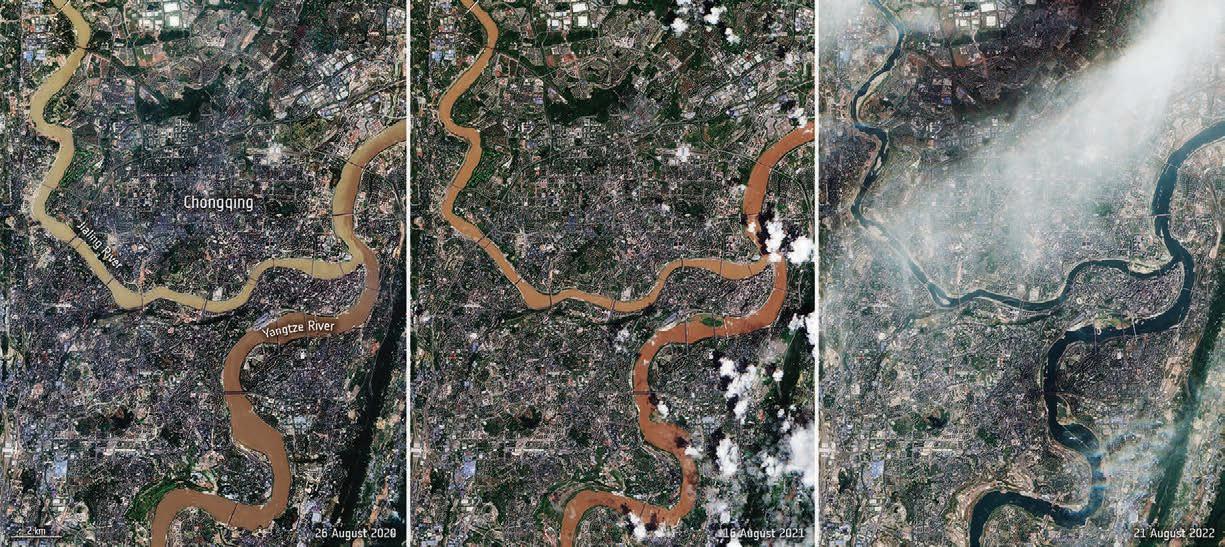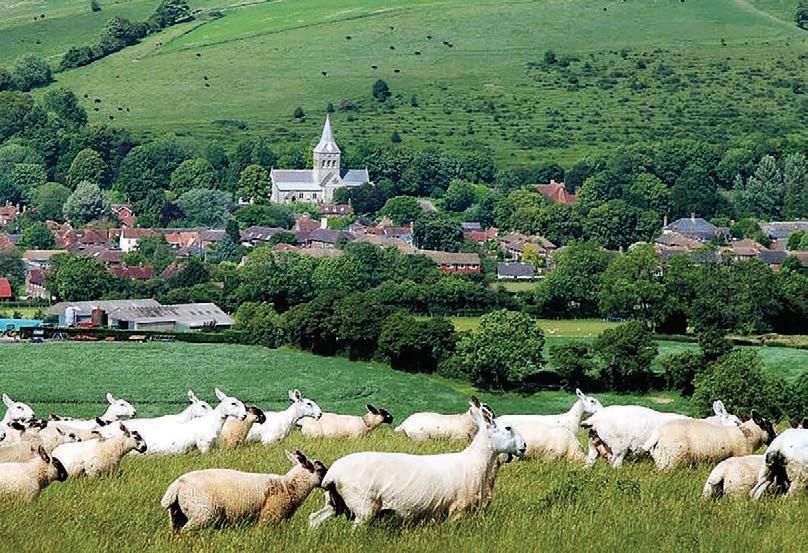
7 minute read
World
China faces water crisis it can’t dam up
CHINA is facing increasing pressure on water resources from a combination of climate change, continued economic development and an increasing population.
The increasing impact of drought in China will have profound impacts across the globe with regard to food security and social stability.
The climate change issue, drought and an economic slowdown are creating a challenging set of circumstances for a country used to economic expansion, and an improving quality of life – especially in the cities.
China is no stranger to drought, though, having suffered crippling dry spells that led in part to the development of dam systems designed to capture and hold fresh water – mostly to assist with agriculture.
This dam network has done well in times of temporary drought but struggles with multi-year drought events.
The current dry spell has broken records all over the country, with lakes and rivers drying up amid searing temperatures.
China recently issued its first national drought alert of the year as authorities battled forest fires and mobilised specialist teams in an attempt to protect crops from the scorching temperatures across the enormous Yangtze River basin.
Regions from Sichuan in the southwest to Shanghai in the Yangtze delta have experienced weeks of extreme heat, with government officials repeatedly citing global climate change as the cause.
In one of the Yangtze’s important flood basins in central China’s Jiangxi province, the Poyang Lake – the largest in the country – has shrunk to a quarter of its normal size for this time of year, according to the state news agency Xinhua.
As many as 66 rivers across 34 counties in southwestern China have reportedly dried up due to the scorching heat, with rainfall in some parts of the country down by as much 60% from usual levels.
The drought is also placing greater demands on China’s power generation capacity, with some regions reducing hydropower electricity generation by up to 50%.
The 11-week heat wave is causing havoc in a region that depends on dams for more than three-quarters of its electricity generation. Many cities around the country have imposed rolling blackouts or are limiting energy use. In some places factories have had to close.
The reduced hydroelectric dam output has also forced China to burn more coal, a large contributor to air pollution and to the greenhouse gas emissions that cause global warming.
The ruling Communist Party is already struggling to reverse a wider economic slowdown in China, caused by the country’s strict covid lockdowns and a slumping real estate market that has sparked a mortgage revolt in some cities.
Young people are finding it hard to get jobs, and concern over the immediate economic outlook has residents slamming their wallets shut.
Economists in the country are also concerned about the impact of a lasting drought on the autumn harvest, which accounts for 75% of China’s total grain output.
However, China has limited potential to increase water supply as demands on major rivers are already hugely significant. Instead it must look to managing water demand, especially in agriculture.
Increasingly China is seeing it has to change its approach to managing drought to become far more proactive, with more attention paid to monitoring, prediction and modelling of rainfall levels and the impact on freshwater resources.
By some estimates, two billion people or more in some 18 countries across the region depend upon a dozen or so major rivers, most of which originate on the Tibetan plateau in the southwest of China. These waterways include the Indus, Brahmaputra, Mekong, Yangtze, Yellow, Irrawaddy and others.
China has built thousands of dams on these rivers, although the amount of water captured by them is radically reducing in some years.
The issue also has a political dimension, with China’s neighbours accusing it of exerting undue influence in damming rivers like the Brahmaputra, which runs through Bangladesh and India to join with the Ganges-Padma River, ending up in the Bay of Bengal.
China’s leaders are well aware of the role water has played in the demise of many of the country’s pre-communist dynasties; brought down by the impact of food shortages and hunger among the population.
Climate change will continue to intensify the impact of drought as higher temperatures increase water use across agriculture and urban areas while reducing runoff into dams.
The scenario ultimately threatens to play out as severe hunger or famine as China struggles to feed its people and has to import large amounts of grain and other produce. That in turn could have a profound impact on world grain prices, also currently higher than normal due to the war in Ukraine. It is interesting to note that China lifted a ban on Russian wheat imports just hours after Russia attacked Ukraine in February.
Although China is the world’s largest wheat producer, the country has been a sizable importer as demand, including for animal feed, continues to outstrip domestic supply.
Wheat imports in 2021 and so far in 2022 are way above normal, with China forecast to import at least 9.5 million tonnes of wheat and 6 million tonnes of rice, according to the latest United States Department of Agriculture (USDA) projections. It’s worth noting the USDA also calculates China has a near record 144 million tonnes of wheat currently in storage facilities.
Perhaps the most effective lever to address China’s water shortage issue would be to simply make water more expensive. But the country’s heavy industrial base and its water-dependent farmers plan their businesses on the bedrock of cheap water, and changing that mindset would be extremely difficult.
Managing shortage and demand in a system that has ignored the finite nature of usable ground water in China will have been one of the biggest issues for the Communist Party to grapple with as its 20th Party Congress got underway last week.
But the good news is: in many parts of China right now, the rain is falling at last.
Asia Media Centre
DISAPPEARING: A record-breaking drought has caused parts of the Yangtze River to dry up – affecting hydropower, shipping routes, limiting drinking water supplies and even revealing previously submerged Buddhist statues. Photo: Wikimedia Commons/Copernicus Sentinel data 2020-2022
Lamb, butter early victims of cost of living crunch
LAMB and butter are the first casualties of the cost of living crisis in the United Kingdom’s meat and dairy market, as consumers switch to cheaper options.
According to agricultural levy body AHDB, using data from research analyst Kantar, retail lamb sales were down 18% year on year, with butter falling 10%, as shoppers seek alternatives to combat food inflation of more than 13%.
The figures, which cover September 2021 to the same month in 2022, also show consumer confidence fell to its lowest level since records began in 1971, with 59% of households revealing their planned food spend was lower than that of the previous year.
According to a YouGov AHDB tracker, 26% of people said they would be eating less meat, with more than half of those saying it was down to price. Lamb is seen to be the main casualty, as people opt for cheaper options, such as pork and poultry.
AHDB retail insight manager Rebecca Gladman said the results showed that, as in the recession of 2008, consumers moved quickly to find cheaper alternatives.
A prime example of this is block butter, which has once again been one first items to be switched after increasing more than 14% in price in June alone.
“The price differential between block butter and margarine has elevated recently despite input costs for margarines increasing as well,” Gladman said.
However, Gladman flagged one difference: in 2008 consumers substituted block butter for margarine in sandwiches and as a spread, but they remained faithful to the product for baking, which she described as its “traditional heartland”. However, recent rises have seen butter sales drop in this area too.
“This creates a bit of a risk as shoppers look to trade down or potentially cut items from their basket altogether,” she said.
While the findings were of concern, the market does provide plenty of opportunity for these two products to bounce back.
Kim Heath, senior retail insight manager at AHDB, said: “Obviously items at a higher price point are the first thing to be hit – that is not a surprise.
“But there are plenty of opportunities for these two areas to make ground. Firstly, scratch cooking sectors and treats at home – where more people are trying to recreate restaurant-standard food at home or batch cooking in order to save money – lamb is great for that.
“And also for butter and its use in baking.
“With Christmas and Easter coming up there is plenty of opportunity for the dairy industry to make the most of the benefits of traditional recipes and home baking.”






